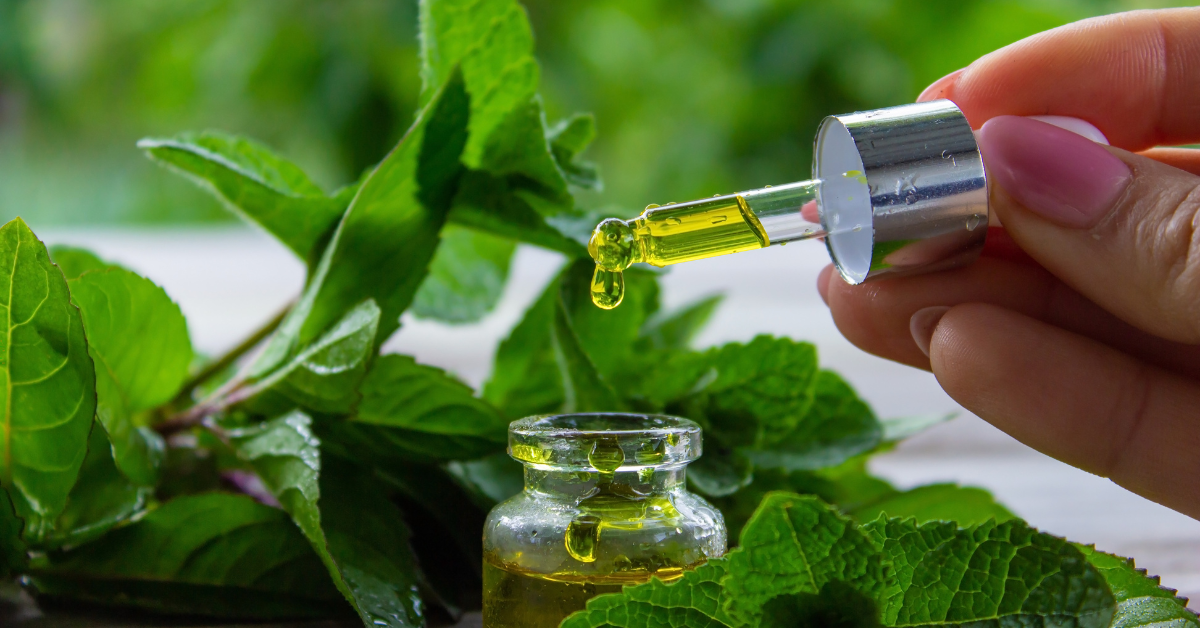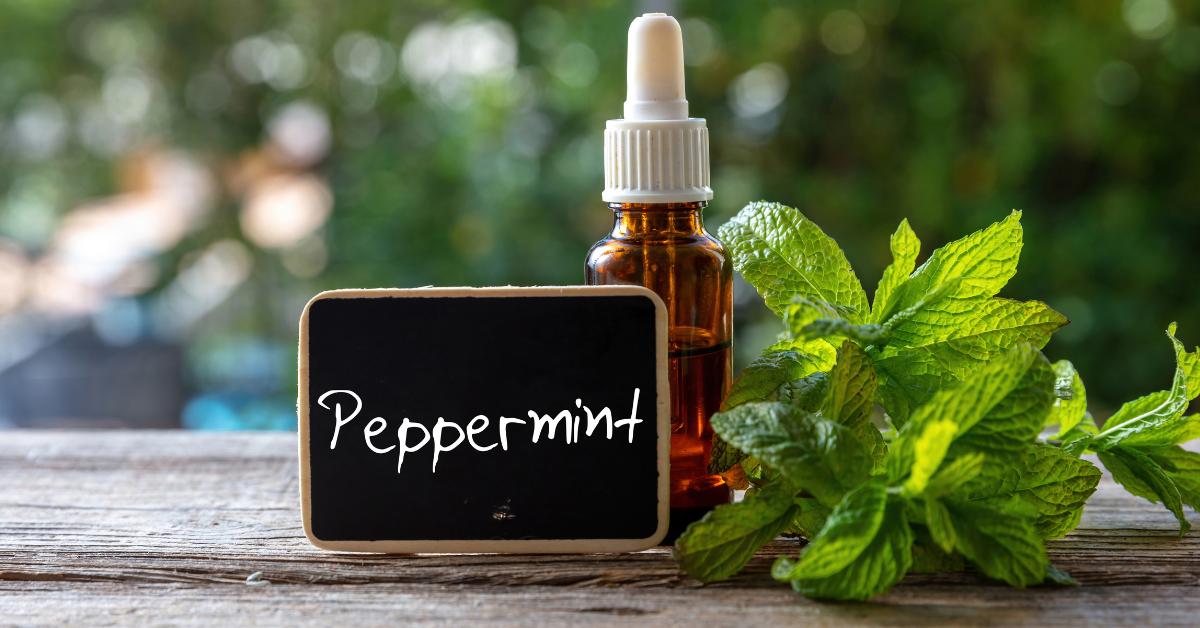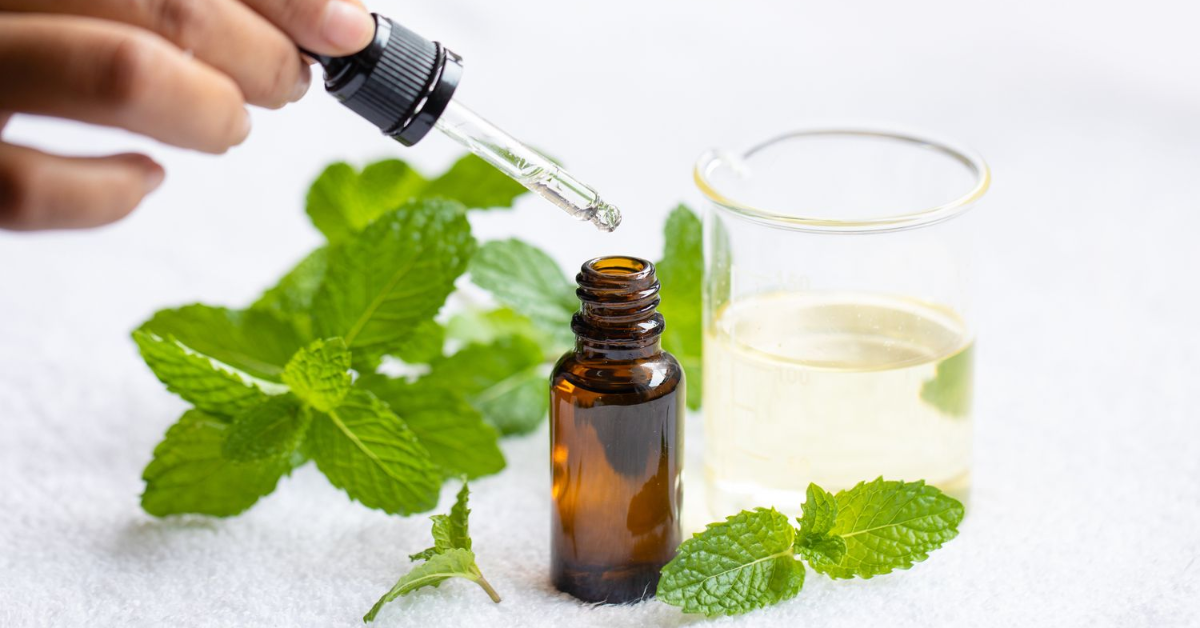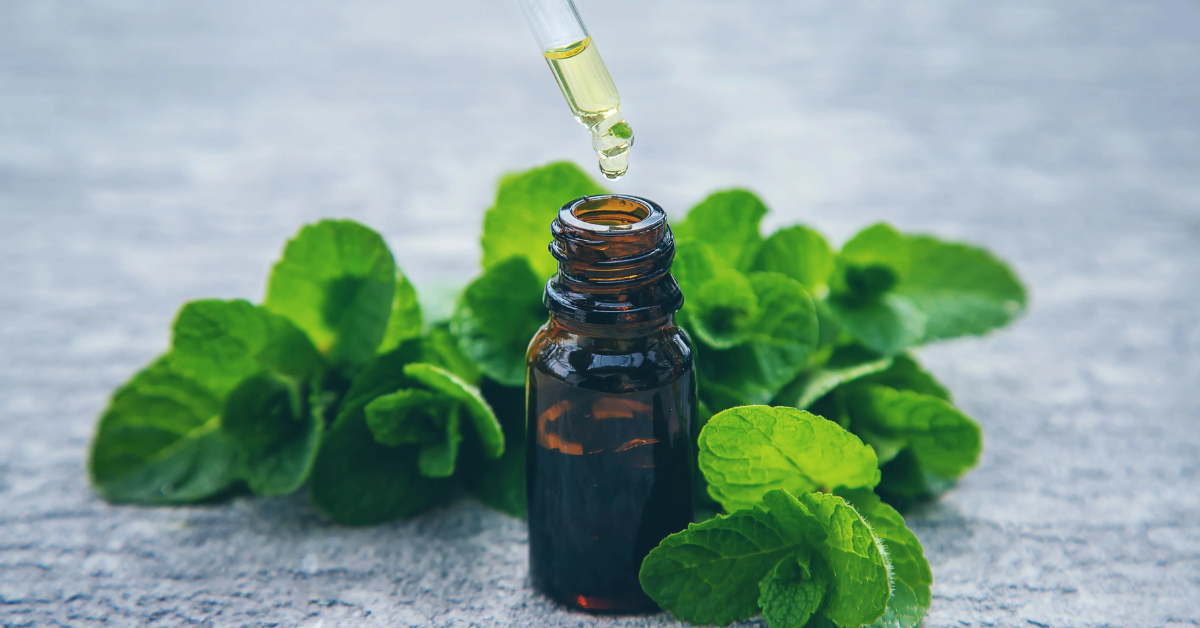Peppermint aromatherapy oil provides a refreshing, minty aroma that energises the mind and soothes the body. A study found that a 10 % peppermint oil solution applied to the forehead and temples significantly reduced tension-type headache intensity within 15 minutes, similar to acetaminophen. Peppermint essential oil is widely used for easing headaches and promoting mental clarity. In today’s article, we will explore the benefits of peppermint aromatherapy oil and its uses. Let’s dive in.
What is Peppermint Essential Oil?
Peppermint essential oil is a potent aromatic extract derived from the leaves and flowering parts of the peppermint plant (Mentha × piperita). It is most commonly extracted by steam distillation, where steam passes through plant material, vaporising the volatile compounds. The essential oil is separated from the water when the vapours condense into liquid form. Consequently, it preserves the oil’s therapeutic and aromatic properties.
Compound of Peppermint Essential Oil

There are several compounds associated with peppermint essential oil. Such as:
Menthol
30–55% of peppermint oil contains menthol, a monoterpene alcohol that gives peppermint its cooling sensation. It activates TRPM8 ion channels, contributing to peppermint’s sharp, minty aroma and characteristic sensory experience.
Menthone
Peppermint has a distinctive aroma because it contains menthone, which comprises 14–32% of its monoterpene ketone. It acts as a biosynthetic precursor to menthol and influences the oil’s volatility and overall fragrance profile.
Isomenthone
Isomenthone, 1.5–10%, is a structural isomer of menthone. It subtly modifies peppermint’s aroma complexity and is often used to differentiate peppermint chemotypes in compositional analysis.
Menthyl Acetate
Menthyl acetate, 2.8–10%, is a monoterpene ester adding a soft, sweet note to peppermint oil. Its presence balances menthol and menthone, and serves as a freshness marker.
1,8-Cineole
1,8-Cineole (eucalyptol), 3.5–8%, is a monoterpene oxide providing fresh, bright top notes. It influences peppermint oil’s aroma and is often used in quality assessments.
Limonene
Limonene, 1–3.5%, is a monoterpene hydrocarbon contributing subtle citrus-mint facets. Though minor, it impacts fragrance perception and can oxidise over time, requiring careful storage.
Menthofuran
Menthofuran, 1–8%, is a monoterpene furan affecting aroma and pungency. High levels are controlled due to toxicity concerns, making it a key parameter in quality-compliant oils.
Pulegone
Pulegone, up to 3%, is a monoterpene ketone precursor in mint biosynthesis. Its potential hepatotoxicity mandates low concentrations in pharmaceutical-grade peppermint oil.
Carvone
Carvone, ≤1%, is a minor monoterpene ketone more prevalent in spearmint plants. It enhances aroma complexity and serves as a chemical marker for origin or adulteration.
Benefits of Peppermint Aromatherapy Oil

Peppermint oil for aromatherapy offers a range of therapeutic benefits, supported by scientific research. Below are some key advantages:
Enhances Cognitive Function
Inhaling peppermint aroma has been shown to improve attention, working memory, and visual-motor response. A study found that peppermint aroma improved tasks related to attentional processes, virtual recognition memory, working memory, and visual-motor response.
Alleviates Digestive Discomfort
Peppermint oil is better than a placebo at improving overall IBS symptoms and reducing abdominal pain. A 2021 study found that 1,030 participants highlighted its effectiveness.
Reduces Nausea and Vomiting
Inhaling peppermint oil has been shown to reduce symptoms of nausea and vomiting in postoperative, chemotherapy, and pregnancy settings. A study reported a notable reduction at 48 hours.
Alleviates Headache Pain
Peppermint oil is as effective as lidocaine drops in reducing headache intensity. A 2019 study comparing the effects of peppermint oil and lidocaine drops for migraine attacks found that headache intensity decreased in 40% of patients receiving either drop.
Relieves Muscle and Joint Pain
Peppermint oil has been shown to increase cutaneous blood flow, which could help relieve muscle and joint pain. A 2016 study examining the effects of topical menthol found that topically applied menthol increases skin blood flow.
Exhibits Antimicrobial Properties
Peppermint essential oil has been shown to possess antimicrobial activity against various bacteria and fungi. A study highlighted its antibacterial activity on different strains of bacteria, including Staphylococcus aureus, Escherichia coli, and Klebsiella pneumoniae.
How to Use Peppermint Aromatherapy Oil Safely

You can enjoy peppermint aromatherapy oil effectively when you use it carefully. Always choose safe application methods and follow proper precautions.
Diffusion
You can diffuse peppermint essential oil by adding a few drops to your diffuser. Always run your diffuser in a well-ventilated area. Sessions should be limited to short intervals, about 15–30 minutes only. Avoid continuous diffusion to prevent discomfort. This way, you breathe the aroma safely without irritating your lungs or causing dizziness.
Topical Application with Dilution
You should always dilute peppermint oil before applying it to your skin. Mix a few drops with a carrier oil. Keep the concentration around 1–2% for adult use. Always test on a small skin area first. Wait 24 hours to check for redness or irritation. Doing this allows you to safely enjoy peppermint oil without harming your skin.
Direct Inhalation
You may use a tissue or cotton ball to inhale peppermint oil for aromatherapy. Add just one or two diluted drops to the surface. Hold it gently near your nose and breathe slowly. Limit your inhalation session to only a few minutes. Longer use may cause headaches or throat irritation. Keep it short, safe, and effective.
Safety Around Children
Avoid using peppermint aromatherapy oil near infants or very young children. Their sensitive lungs react strongly to menthol vapors. Always check your child’s age before use. Only apply diluted solutions to children older than six. Use a very low dilution, around 0.25–0.5%. By practicing caution, you protect your child’s safety while still enjoying aromatherapy benefits.
Precautions for Pets
Peppermint essential oil should be used cautiously around pets. Cats and dogs are susceptible to essential oils. Never diffuse in a closed room with animals present. Always ensure proper airflow and an exit for pets. If you notice unusual behavior, stop immediately. This way, your pets stay safe while you enjoy aromatherapy.
Storage and Health Considerations
You should store peppermint essential oil in a dark glass bottle, away from heat and sunlight. Always keep it out of children’s reach. If you have certain health conditions, consult your doctor first. Avoid use if you have gallbladder disease or specific enzyme deficiencies. Using peppermint oil wisely ensures you benefit safely without harmful interactions or accidents.
Safety and Side Effects of Peppermint Aromatherapy Oil

Peppermint aromatherapy oil is generally safe, but you should be aware of possible side effects and precautions. Peppermint oil may cause mild digestive issues like nausea, heartburn, or dry mouth when taken improperly. Topical use can sometimes trigger skin irritation, redness, or allergic reactions.
Infants and young children are especially vulnerable, as inhalation can cause severe breathing problems. In rare cases, high doses have been linked to seizures, slowed heartbeat, or respiratory complications.
Is It Safe to Breathe in Peppermint Essential Oil?
Inhaling peppermint essential oil is generally considered safe when used appropriately. Aromatherapy with peppermint oil may help alleviate symptoms like nausea and improve focus. However, it’s necessary to use it in moderation and ensure proper dilution. Avoid direct inhalation of undiluted oil, as it can cause respiratory irritation.
What is Peppermint Aromatherapy Oil Good For?
Peppermint aromatherapy oil offers multiple benefits, supporting your mind, body, and overall wellness through safe and effective usage.
- Enhance Focus and Mental Clarity – The refreshing aroma stimulates the brain, improving attention, memory, and alertness.
- Relieve Headaches and Migraines – Inhalation or diluted topical application on the temples can reduce headache intensity.
- Support Digestive Health – Inhalation or gentle topical use may help relieve bloating, nausea, and indigestion.
- Reduce Muscle and Joint Pain – Topical application (diluted) can help soothe sore muscles.
- Combat Fatigue – Its invigorating scent helps energize and reduce tiredness.
Read More: Rosemary Aromatherapy Oil: Benefits and Uses
Conclusion
Peppermint aromatherapy oil provides enhanced focus, headache relief, and digestive comfort. Using it safely ensures effectiveness and prevents irritation. Always dilute before topical use and limit direct inhalation. Keep the oil away from children, infants, and pets. Proper storage and consulting a healthcare provider help avoid risks. The therapeutic properties of peppermint oil can be enjoyed by following the precautions.

